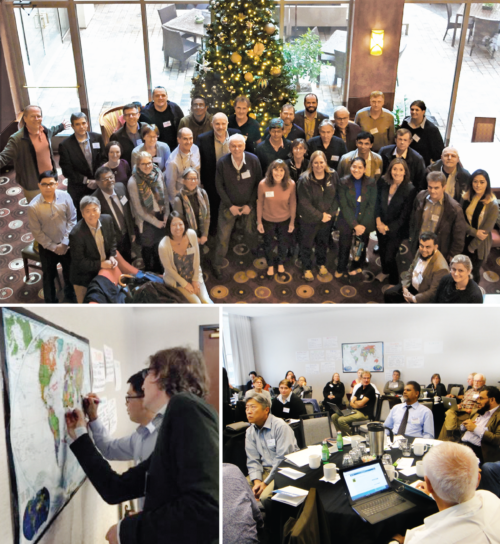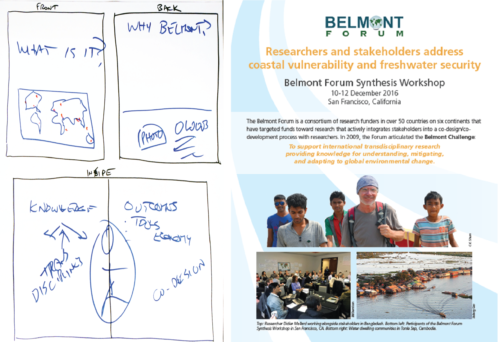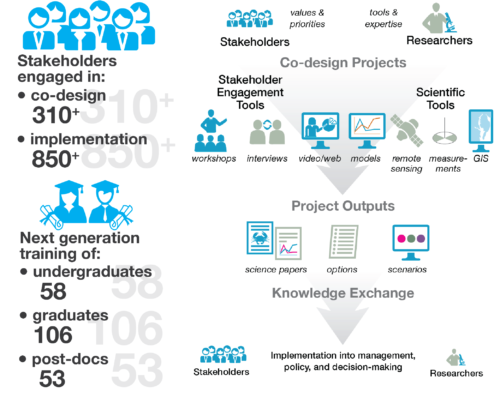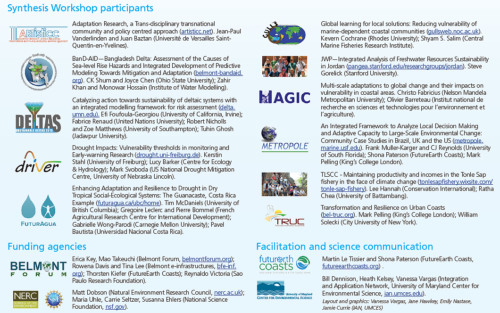Co-development of the Belmont Forum synthesis document
Vanessa Vargas-Nguyen ·Last December 2016, Bill Dennison, Heath Kelsey and I teamed up with our partners at Future Earth’s Coasts, Martin LeTissier and Shona Paterson, to facilitate the Synthesis Workshop for the 13 Belmont Forum funded transdisciplinary projects in Coastal Vulnerability and Freshwater Security. During that time, Bill’s awesome songs were not the only ones that were produced; we also co-developed a draft Synthesis document with all the participants. And now, after about 3 months of consultation and revisions, we have now completed the first synthesis document for two Belmont Forum funded Collaborative Research Actions (CRA) themed projects.

The co-development of this Synthesis document, I would say, occurred in three phases – before the workshop, during the workshop, and after the workshop. This is reflected in the evolution of the Synthesis document from a 4 pager storyboard, to a trifold draft, and then to an 8-page final document. It is typical for IAN to have a product (newsletter/report card) after a workshop, but, we initially did not know what to expect with the Belmont Forum workshop. After the initial meeting with Erica Key, executive director of the Belmont Forum, it became clear to us that this workshop would not be like any other. We ended up helping Erica with the questionnaire she was developing that each project teams would need to complete prior to the workshop. This helped us a lot in familiarizing ourselves with the different projects and in structuring our approach.

With the survey results, we were able to create an infographic showing stakeholder engagement and academic training provided by both CRAs. The funders particularly loved this figure as it highlighted both the strength and achievement of the Belmont Forum initiative. For them, this one graphic is one of the best advertisement they can give to prospective funders. Some researchers, though, were not comfortable in giving exact numbers in stakeholder engagement since each projects counted differently. To reach a happy medium, we opted to give an estimate. We also created a diagram illustrating the co-design approach and the subsequent knowledge exchange between researchers and stakeholders.

In addition to the survey, we prepared a template that each project would use for their presentation, centered around six themes: (1) project highlights in terms of content/results and (2) in terms of the co-design/co-development process; (3) benefits and (4) challenges of transdisciplinary thinking; and (5) key achievements and (6) gaps in addressing the CRA. All of the presentations occurred on the first day of the workshop. On the second day, we had the participants break out in 6 groups to summarize each theme. Their output resulted to the “Common themes” section in the Synthesis document. From the discussions with the project leaders, we were also able to identify a variety of priority actions to aid in the implementation of project outcomes for future efforts.
During the workshop, Bill introduced the participants with conceptionary and the A-B-T rubrics. We asked each project teams to come up with an 80 word ABT statement to describe their projects and to nominate visuals that we could include in the document. This was no easy feat, considering the magnitude of work and achievements each project was able to do and accomplished. This exercise then populated the "Project summary" section of the document. Even the Belmont Forum secretariat created an ABT of their own, which became part of the document's introduction. Because the projects involved international collaborations, we thought it would be very powerful to have a visual showcasing this. So, we brought a world map and asked the participants to marked the different places where their projects were active using markers that were color-coded for each project.

With all the elements for the newsletter already drafted by the participants, we were able to create a draft that the participants were able to review and comment on before leaving San Francisco. What followed was a period of continuous communications and solicitation of edits and comments between the facilitation team and the participants. IAN staff Jane Hawkey, Emily Nastase and Jamie Currie also helped in editing the document. The biggest challenge was to effectively synthesize the project outcomes to reflect the great work and the valuable contribution of the Belmont forum and the project teams, both separately and collectively, to science and society. We hope that this Synthesis document serves as proof that collaboration between researchers and stakeholders can facilitate a variety of cascading actions.

About the author
Vanessa Vargas-Nguyen

Dr. Vanessa Vargas-Nguyen is a Science Integrator with the Integration and Application Network and an associate faculty of the Marine Estuarine and Environmental Science Graduate Program. Her current interest is in transdisciplinary approaches, socio-environmental assessments, socio-environmental justice, stakeholder engagement, and adaptive environmental governance. Vanessa is originally from the Philippines and has extensive experience in molecular biology and marine science, specializing in microbial communities and molecular processes associated with Harmful Algal Blooms and shrimp, corals, and human diseases. She has since shifted her focus on how science can benefit society and was conferred with the first Ph.D. under the new Environment and Society foundation of the MEES graduate program. Her dissertation used ethnographic approaches to investigate the role of socio-environmental report cards in transdisciplinary collaboration and adaptive governance for a sustainable future. She received academic training from the University of the Philippines (BSc; MSc) and the University of Maryland (MSc; PhD). She is involved in developing holistic socio-environmental assessments for complex systems such as the Mississippi River and Chesapeake Bay watersheds and is coordinating a multi-year international transdisciplinary research consortium involving the US, Norway, Philippines, Japan, and India.